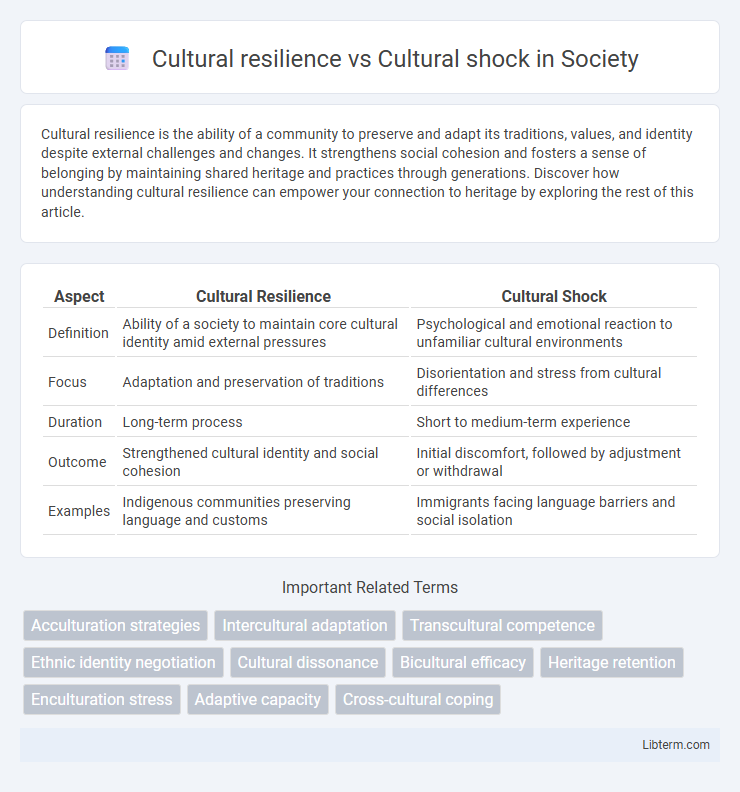Cultural resilience is the ability of a community to preserve and adapt its traditions, values, and identity despite external challenges and changes. It strengthens social cohesion and fosters a sense of belonging by maintaining shared heritage and practices through generations. Discover how understanding cultural resilience can empower your connection to heritage by exploring the rest of this article.
Table of Comparison
| Aspect | Cultural Resilience | Cultural Shock |
|---|---|---|
| Definition | Ability of a society to maintain core cultural identity amid external pressures | Psychological and emotional reaction to unfamiliar cultural environments |
| Focus | Adaptation and preservation of traditions | Disorientation and stress from cultural differences |
| Duration | Long-term process | Short to medium-term experience |
| Outcome | Strengthened cultural identity and social cohesion | Initial discomfort, followed by adjustment or withdrawal |
| Examples | Indigenous communities preserving language and customs | Immigrants facing language barriers and social isolation |
Understanding Cultural Resilience
Cultural resilience refers to the ability of individuals or communities to maintain and adapt their cultural identity and practices when faced with external pressures or changes, such as migration or globalization. Understanding cultural resilience involves recognizing how traditions, values, and social networks provide emotional strength and continuity, enabling people to cope with cultural disruptions without losing their sense of self. This concept contrasts with cultural shock, which describes the initial disorientation and stress experienced when encountering a markedly different culture.
Defining Cultural Shock
Cultural shock refers to the feelings of confusion, anxiety, and disorientation experienced when encountering a new and unfamiliar cultural environment. This phenomenon often arises from differences in language, social norms, and daily routines, challenging individuals to adapt quickly. Understanding cultural shock is essential for developing cultural resilience, which enables individuals to cope, recover, and thrive amid cultural transitions.
Key Differences Between Resilience and Shock
Cultural resilience refers to an individual's or community's ability to adapt, recover, and thrive when encountering new cultural environments, while cultural shock is the initial disorientation and stress experienced upon exposure to unfamiliar cultural norms. The key difference lies in resilience facilitating positive adaptation and growth, whereas shock represents temporary discomfort or confusion before adjustment. Understanding these concepts is crucial for effective cross-cultural communication and successful integration in multicultural settings.
Factors Influencing Cultural Resilience
Cultural resilience is shaped by factors such as community cohesion, strong cultural identity, and adaptive traditions that enable individuals to maintain stability during change. Supportive social networks and intergenerational knowledge transfer enhance coping mechanisms, allowing societies to withstand external pressures. In contrast, cultural shock arises when individuals face unfamiliar norms without adequate resources or support, highlighting the importance of these resilience factors.
Causes and Stages of Cultural Shock
Cultural shock arises from the disorientation experienced when individuals encounter unfamiliar customs, language barriers, and social norms, often triggered by migration or travel. Its stages include the honeymoon phase of excitement, the frustration phase characterized by confusion and alienation, the adjustment phase where acclimatization occurs, and finally, the acceptance or adaptation phase. Cultural resilience counters these effects by fostering emotional strength, cultural awareness, and adaptive strategies that help individuals navigate and integrate new cultural environments effectively.
Coping Strategies for Navigating Cultural Shock
Effective coping strategies for navigating cultural shock include developing cultural resilience through adaptive learning, open-mindedness, and building supportive social networks. Mindfulness practices and maintaining a flexible mindset help individuals interpret new cultural norms without judgment, reducing stress and facilitating smoother adjustment. Engaging in community activities and seeking intercultural communication skills bolster confidence and promote emotional stability during cultural transitions.
Building Cultural Resilience in New Environments
Building cultural resilience in new environments involves developing adaptability, open-mindedness, and effective communication skills to navigate unfamiliar social norms and practices. Immersing oneself in local customs and seeking support networks enhances emotional strength and reduces the impact of culture shock symptoms such as anxiety and disorientation. Proactive strategies like continuous cultural learning and mindfulness foster long-term adjustment and well-being in diverse cultural settings.
The Role of Community in Strengthening Resilience
Community networks provide vital support systems that enhance cultural resilience by fostering shared identity, traditions, and mutual aid, enabling individuals to navigate cultural shock effectively. Strong social ties within cultural communities facilitate the preservation of language, customs, and values, which act as protective buffers against the disorientation caused by new cultural environments. Collective participation in cultural events and institutions strengthens emotional well-being and adaptability, making community involvement essential in overcoming the challenges of cultural shock.
Long-term Impacts of Cultural Shock vs. Resilience
Cultural shock often results in long-term psychological stress, social isolation, and identity confusion, undermining an individual's well-being and adaptation processes. In contrast, cultural resilience fosters sustained emotional strength, social integration, and adaptive strategies that enhance cross-cultural competence and personal growth over time. Research highlights that individuals exhibiting cultural resilience experience fewer negative health outcomes and maintain higher life satisfaction despite prolonged exposure to new cultural environments.
Fostering Adaptation: From Shock to Resilience
Cultural resilience develops through the ability to navigate cultural shock by embracing new perspectives and adapting behaviors in unfamiliar environments. Exposure to diverse cultural experiences triggers initial disorientation but promotes personal growth and intercultural competence, essential for long-term adaptation. Strategies such as open-minded communication, empathy, and cultural learning transform cultural shock into sustained resilience, enabling individuals to thrive in multicultural settings.
Cultural resilience Infographic

 libterm.com
libterm.com